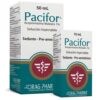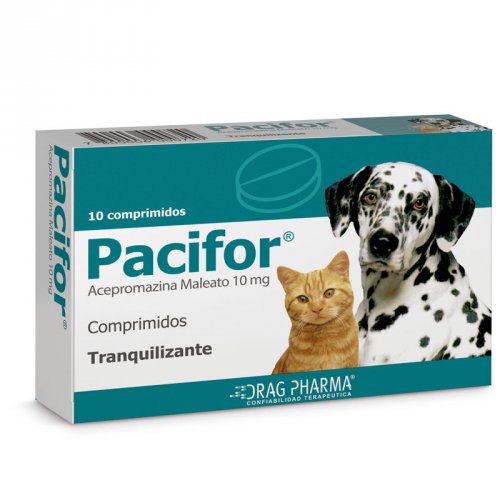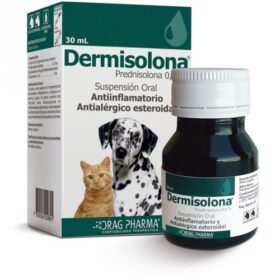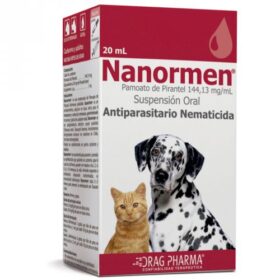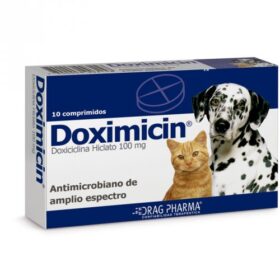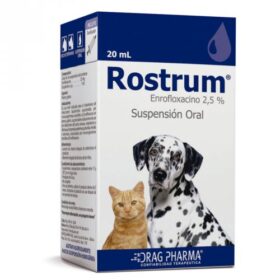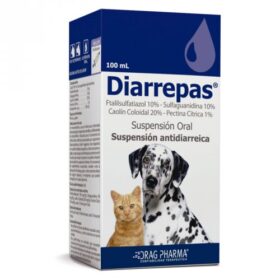- Your cart is empty
- Continue Shopping
Product Description
SPECIES
Dogs and cats.
DOSAGE FORM
Oral solution
THERAPEUTIC ACTION
Tranquilizer
COMPOSITION
Each 100 mL of solution contains:
Accepromazine Maleate …………….. 1.35 g
(Equivalent to 1 g of acepromazine base)
Excipients q.s.p… …………………. 100 mL
INDICATIONS
Pacifor® Oral solution, is indicated as a sedative (tranquilizer) agent for dogs and cats.
USE INSTRUCTIONS
The calming effect takes between 30 and 40 minutes. Place the animal in a calm environment. The duration of the effect is 6 to 12 hours.
ROUTE OD ADMINISTRATION AND DOSAGE
Oral Administration.
Product dosage:
- Dogs: 1 to 2 drops per Kg of weight (0.5 to 1 mg / Kg).
- Cats 2 to 3 drops per Kg of weight (1 to 1.5 mg / Kg).
DRUG INTERACTIONS
- Combinations of antidiarrheals (eg Kaolin-Pectin, mixtures with Bismuth Subsalicylate) and antacids can reduce gastrointestinal absorption of orally administered phenothiazines.
- Depressants of the Central Nervous System (CNS) (barbiturates, narcotics, anesthetics, etc.), can exacerbate CNS depression if used together with Accepromazine.
- Epinephrine: Phenothiazines block alpha-adrenergic receptors; concomitant administration with epinephrine can lead to beta activity causing vasodilation and increased heart rate.
- Opioids: May improve the hypotensive effects of Accepromazine. Accepromazine doses are generally reduced when used with an opiate.
- Organophosphate agents: Accepromazine should not be administered within one month of deworming with these agents as their effects may be potentiated.
- Phenytoin: Your metabolism may decrease if given simultaneously with phenothiazines.
- Procaine: Activity can be enhanced by phenothiazines.
- Propranolol: Co-administration of Acepromazine and Propanolol can lead to serum elevation of both drugs.
- Quinidine: With phenothiazines it can cause additive cardiac depression.
- Vasocontrictors like Phenylephrine antagonize the hypotensive effects of phenothiazines.
CONTRAINDICATIONS
- Do not administer to pregnant or lactating females.
- Do not use in animals undergoing tests such as myelograms.
- Do not use in animals with a history of seizures.
- Do not administer in animals with hypovolemia or shock, due to its hypotensive effects.
- Do not administer in animals with coagulopathies or thrombocytopenia, due to its effects on the platelet aggregation.
- Do not administer to animals with tetanus or Strychnine poisoning, due to the effects on the extra pyramid system.
- Do not administer within one month of deworming with Organophosphate agents already that its effects can be enhanced.
SPECIAL PRECAUTIONS FOR USE
- After the administration of Accepromazine, lower doses of general anesthetics are required.
- Use with caution and at the lowest recommended dose in animals with liver dysfunction, heart disease and general weakness.
- Use with caution in very young or weakened animals, due to its effects on thermoregulation.
- Use with caution in geriatric patients, as very low doses have been associated with prolonged effects of the drug.
- Accepromazine does not have analgesic effects, so adequate measures should be taken to control pain in treated animals.
- Use with caution in brachycephalic dogs (Boxer, Pekingese, etc.) or cats of the Persian breed, as they can be very sensitive to the bradycardic effects of Accepromazine.
- Use with caution in dogs with MDR1 mutations (Collies, Australian Shepherds, among others), as they can develop a deeper sedation that persists longer than usual.
- Giant breeds and Greyhounds can be extremely sensitive to the drug, while terrier breeds are somewhat resistant to its effects.
- Accepromazine should be used with caution as a containment agent in aggressive dogs, as it may make animals more prone to startle and react to noise or other sensory stimuli.
- Atropine can be used in conjunction with Accepromazine to help block its bradycardic effects.
- During sedation with Accepromazine it is recommended to use eye lubricants or artificial tears as corneal protectors, due to the reduction in tear production.
- A higher dose does not accelerate the onset of sedation, it only lengthens the sedative effect.
- Once it has been administered, it is important to leave the animal in a quiet place for about 15 minutes or until sedative effects are achieved.
- After administration, patients should not be exposed to extreme temperature fluctuations for at least 8 hours.
- Administration in conjunction with other respiratory or central nervous system depressants can exacerbate respiratory depression.
SPECIAL PRECAUTIONS FOR THE OPERATOR
- In the case of ocular exposure, the eyes should be irrigated with plenty of water. If irritation exists and persists, the patient should be evaluated by a doctor.
- In the case of dermal exposure, contaminated clothing should be removed or the exposed area washed thoroughly with water. If irritation exists and it persists, the patient should be evaluated by a doctor.
- In case of accidental ingestion, the mouth should be washed. If there was large intake, immediate medical attention should be requested.
WARNINGS
Keep out of the reach of children.
ADVERSE EFFECTS
- Accepromazine generates hypotension mediated by vasodilation, which can last for a few hours and must be considered during its use. In healthy animals this hypotension is usually mild, however it can be accentuated in anesthetized, weakened or hypovolemic patients.
- Unusual cardiovascular collapse of varying severity (secondary to bradycardia and hypotension) has been described in some dogs, especially in brachycephalic breeds.
- Accepromazine causes significant intraoperative hypothermia because it depresses the hypothalamic thermoregulatory center and causes cutaneous vasodilation. This effect lasts for a few hours.
- Accepromazine causes prolapse of the nictitating membrane, which lasts for a few hours while maintaining its effect.
- Accepromazine may decrease hematocrit for several hours, as a result of splenic congestion after α1-adrenergic receptor blockage, which may be important in anemic animals. This effect is transitory and is restored after several hours.
- Accepromazine transiently decreases platelet aggregation without affecting clotting times.
- Occasionally Accepromazine can generate contradictory clinical signs of aggressiveness and generalized stimulation of the Central Nervous System. These reactions are infrequent and transient in nature and generally do not last for more than 48 hours.
OBSERVATIONS
Special precautions for the disposal of unused product or waste material:
- Discard the remains of unused product in its original container.
- Do not throw the empty container or with product remains, in rivers, lakes or torrents of water.
- Do not reuse the container.
- Dispose of this product with caution with household waste.
CONSERVATION
Store between 15 ° and 30° C, protected from light. Once the container is opened, use within 12 weeks. Discard the unused product after that period of time.
CONDITION OF SALE
Sale with Veterinary Medical prescription.
PRESENTATION
Dropper bottle with 10 mL
PREPARED BY
Laboratorio Drag Pharma Chile Invetec S.A.
RECORDS
Chile: Reg. SAG N°: 0516
Bolivia: Reg. SENASAG PUV-F-N° 005517/13

